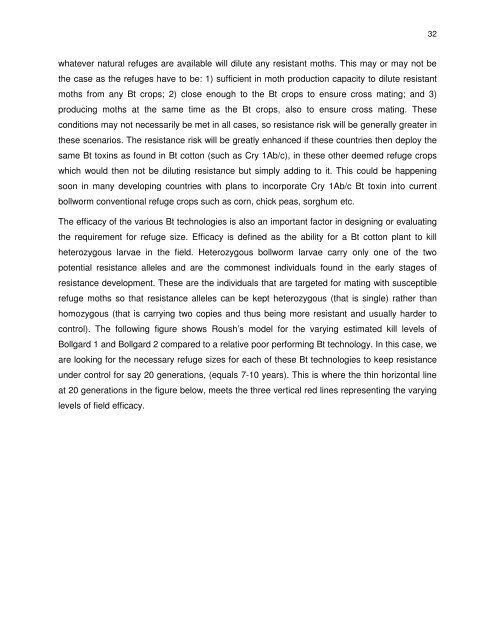ChangingCottonLandscapeNeilForrester
ChangingCottonLandscapeNeilForrester
ChangingCottonLandscapeNeilForrester
Create successful ePaper yourself
Turn your PDF publications into a flip-book with our unique Google optimized e-Paper software.
whatever natural refuges are available will dilute any resistant moths. This may or may not be<br />
the case as the refuges have to be: 1) sufficient in moth production capacity to dilute resistant<br />
moths from any Bt crops; 2) close enough to the Bt crops to ensure cross mating; and 3)<br />
producing moths at the same time as the Bt crops, also to ensure cross mating. These<br />
conditions may not necessarily be met in all cases, so resistance risk will be generally greater in<br />
these scenarios. The resistance risk will be greatly enhanced if these countries then deploy the<br />
same Bt toxins as found in Bt cotton (such as Cry 1Ab/c), in these other deemed refuge crops<br />
which would then not be diluting resistance but simply adding to it. This could be happening<br />
soon in many developing countries with plans to incorporate Cry 1Ab/c Bt toxin into current<br />
bollworm conventional refuge crops such as corn, chick peas, sorghum etc.<br />
The efficacy of the various Bt technologies is also an important factor in designing or evaluating<br />
the requirement for refuge size. Efficacy is defined as the ability for a Bt cotton plant to kill<br />
heterozygous larvae in the field. Heterozygous bollworm larvae carry only one of the two<br />
potential resistance alleles and are the commonest individuals found in the early stages of<br />
resistance development. These are the individuals that are targeted for mating with susceptible<br />
refuge moths so that resistance alleles can be kept heterozygous (that is single) rather than<br />
homozygous (that is carrying two copies and thus being more resistant and usually harder to<br />
control). The following figure shows Roush’s model for the varying estimated kill levels of<br />
Bollgard 1 and Bollgard 2 compared to a relative poor performing Bt technology. In this case, we<br />
are looking for the necessary refuge sizes for each of these Bt technologies to keep resistance<br />
under control for say 20 generations, (equals 7-10 years). This is where the thin horizontal line<br />
at 20 generations in the figure below, meets the three vertical red lines representing the varying<br />
levels of field efficacy.<br />
32


